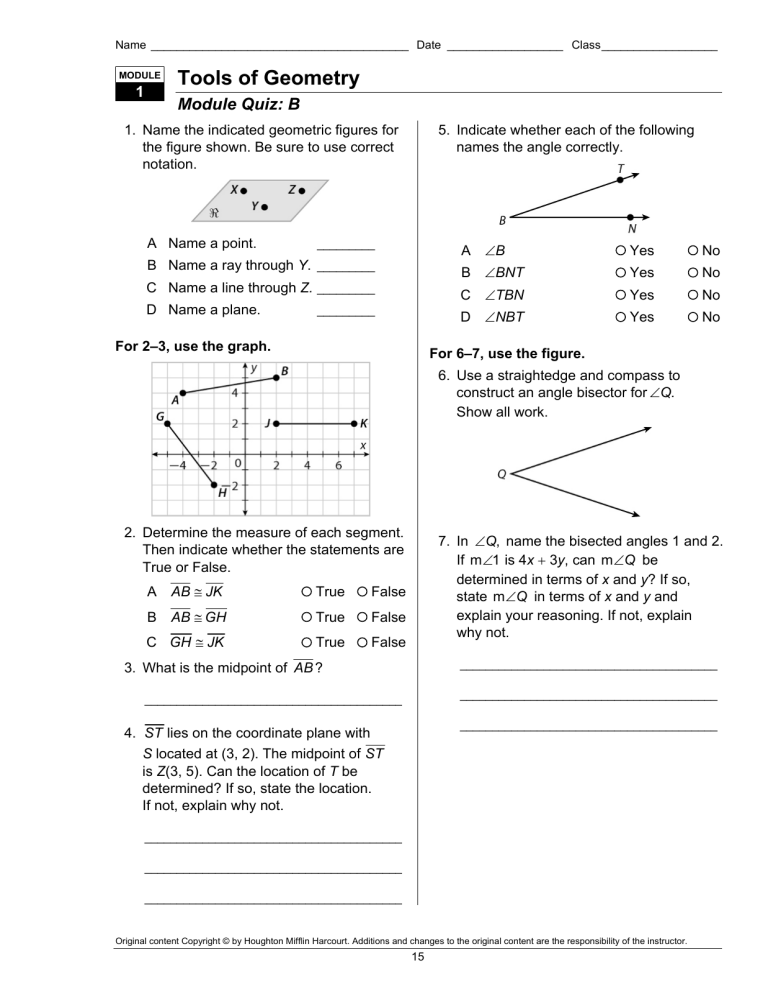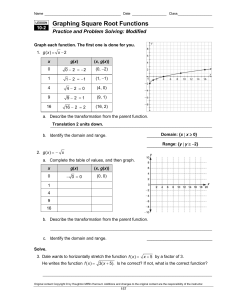Module-1-Review-Venable
advertisement

Name ________________________________________ Date __________________ Class __________________ MODULE 1 Tools of Geometry Module Quiz: B 5. Indicate whether each of the following names the angle correctly. 1. Name the indicated geometric figures for the figure shown. Be sure to use correct notation. A Name a point. _________ B Name a ray through Y. _________ C Name a line through Z. _________ D Name a plane. _________ For 2–3, use the graph. A ∠B Yes No B ∠BNT Yes No C ∠TBN Yes No D ∠NBT Yes No For 6–7, use the figure. 6. Use a straightedge and compass to construct an angle bisector for ∠Q. Show all work. 2. Determine the measure of each segment. Then indicate whether the statements are True or False. A AB ≅ JK True False B AB ≅ GH True False C GH ≅ JK True False 7. In ∠Q, name the bisected angles 1 and 2. If m∠1 is 4x + 3y, can m∠Q be determined in terms of x and y? If so, state m∠Q in terms of x and y and explain your reasoning. If not, explain why not. ________________________________________ 3. What is the midpoint of AB ? ________________________________________ ________________________________________ ________________________________________ 4. ST lies on the coordinate plane with S located at (3, 2). The midpoint of ST is Z(3, 5). Can the location of T be determined? If so, state the location. If not, explain why not. ________________________________________ ________________________________________ ________________________________________ Original content Copyright © by Houghton Mifflin Harcourt. Additions and changes to the original content are the responsibility of the instructor. 15 Name ________________________________________ Date __________________ Class __________________ MODULE 1 Tools of Geometry Module Quiz: B Use the following for 8–9. Use the figure for 13–14. +ABC maps to triangle +A′B′C′. Preimage A( −4, 3) → Image A′(4, 3) B( −3, −3) C (1, 2) → → B′(3, −3) C ′( −1, 2) For the figure, m∠JKL = 54°. 8. State the rule. ________________________________________ 9. Is this a rigid motion? How do you know? 13. Which theorem or postulate can be used to determine m∠MKL? ________________________________________ ________________________________________ ________________________________________ 14. What is m∠MKL? ________________________________________ + 10. Draw the image LKM under the transformation (x, y) → (x + 3, 2y). ________________________________________ Use the transformation below for 15–17. ( x, y ) → (2 x, 1 y) 2 15. Find the image of the points A(0, 0), B(4, 0), C(4, 4), and D(0, 4) under this transformation. ________________________________________ 16. The points in #15 define a square in the xy-coordinate plane. Do the images of these points also define a square? Explain. 11. Using the figure above, is the transformation a rigid motion? Explain. ________________________________________ ________________________________________ ________________________________________ ________________________________________ 17. Is this transformation a rigid motion? Explain. 12. In a figure, m∠1 = m∠2 and m∠2 = m∠3. Which property can be used to reason that m∠1 = m∠3? ________________________________________ ________________________________________ ________________________________________ Original content Copyright © by Houghton Mifflin Harcourt. Additions and changes to the original content are the responsibility of the instructor. 16
